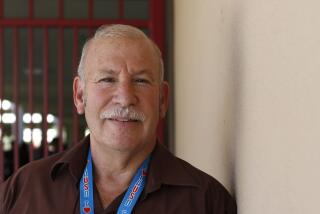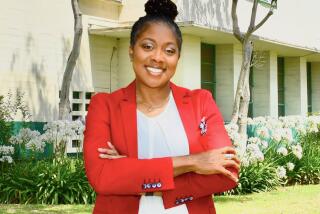A year in, L.A. Unified’s insider superintendent has made no big waves

The school board, in selecting King, did not specify particular measures by which it would evaluate her, and the plans she has made thus far have been broad.
For months after she was named superintendent of the nation’s second-largest school system, Michelle King borrowed a strategy new politicians use to get the lay of the land: She traversed the territory on a “listen and learn” tour.
Although she had been working in the district for 31 years, she held town halls in Pacoima, Huntington Park and Cypress Park.
At schools across the district, she assured parents that she would take their concerns back to district headquarters, where they would help shape an ambitious but practical plan to increase academic achievement and reverse years of declining enrollment.
“It’s not a Michelle vision. It’s going to be an LAUSD plan,” King said at one of her stops. “It’s about all of us.”
A year has passed since board members unanimously chose King to lead the Los Angeles Unified School District, citing her lifetime of experience in the district and deep familiarity with its problems. In King, they saw a competent soldier, a respected former classroom teacher and high school principal who had served as deputy superintendent under two previous superintendents, John Deasy and Ramon C. Cortines.
That competent soldier is, in many respects, what they got.
In her first year, King, the first African American woman to lead the district, has continued the policies of her predecessor, while building on her reputation as a seasoned, likable manager. But what she will do to rescue L.A. Unified from its looming crises remains as unclear today as it was on the day of her promotion.
King inherited a school district that is losing students by the thousands. Squeezed by a growing number of charter schools, a declining birthrate and rising housing costs that have forced some families to move outside the district, L.A. Unified-operated schools currently enroll about 514,000 students, down more than 100,000 since 2009.
During the same period, the number of children in L.A. charter schools — which are publicly funded but privately operated — has roughly doubled.
Money follows students. As its enrollment has fallen, the district has had to cover mounting personnel costs, including obligations to pay retiree medical benefits and higher contributions to the state teachers’ retirement system. The district’s latest projections show that if nothing is done soon, by 2018 the school system will be $252 million in the red.
King took the job after the 14-month tenure of Cortines, who came out of retirement in 2014 to stabilize the school system after Deasy resigned under pressure from the school board. Deasy was determined to weaken the power of the teachers union and advocated the use of student test scores in teacher and school performance evaluations.
Cortines returned with a mandate to calm the waters. He gave teachers a double-digit pay raise, placating the union. He canceled Deasy’s $1.3-billion plan to give every student an iPad, saying it was too costly.
Many district employees, parents and civic leaders saw Cortines as a calming but temporary leader who might one day be succeeded by someone with a bolder agenda. When the board chose King — a self-described LAUSD “lifer” — there was a sense of relief inside the schools.
“Her biggest strength, which I think has been really big, is teacher morale under her leadership has been higher,” said Ama Nyamekye, a former public school teacher and director of the Los Angeles chapter of Educators 4 Excellence, a teacher advocacy group. “She has really approached leadership in a way that feels like, ‘I am with you, I am from you.’ Despite differences, it doesn’t feel like there’s a war.”
Under King, leaders of the disparate groups that play a role in the school district — unions, charter schools, nonprofit organizations — said they have noticed a change in tone filtering down through the ranks and easing old tensions.
But few could point to substantive changes made in the last year. Many of those interviewed for this story, including school board members, said they were still waiting for King to flesh out her plans and address the most serious budgetary issues.
“She presents herself as the flip side of John Deasy,” said John Rogers, a professor of education at UCLA. “At the same time, she has not really been out front to reform and transform the district in the same way that he had been. It’s difficult to discern the imprint that she’s had over the course of this first year.”
In September, King laid out a three-year strategic plan in which she proposed increasing popular school options such as magnets and dual-language programs, and set goals for modest gains. Standardized test scores, student attendance rates, the percentage of students who pass their college-prep courses with a grade of C or better — each of these would rise by 2 percentage points a year, she said, though exactly how was unclear.
Underwhelmed board members told her to aim higher. So back she came in December with a plan that had as its centerpiece a goal that no large, urban school district has ever achieved: a 100% graduation rate.
Months of discussion had led to this point, but the board decided not to vote to endorse the plan, leaving its superintendent to find other ways to meet her goals.
In a brief phone interview earlier this week, King listed the highlights of her first year in office. She mentioned the listening tour, the opening of two all-girls schools — an initiative she has championed, which was in progress before she took over — and an all-boys school slated to open next fall.
She said she intends to give the board quarterly updates, starting in April, on how she will accomplish her goals.
She has more ambitious plans, including a proposal to give poorly performing schools priority when hiring teachers and the creation of a districtwide online enrollment system. She also launched an “innovation unit” to collect and disseminate effective practices across the sprawling school system, and increased the number of classrooms for preschoolers.
Perhaps the clearest example of King’s influence at this point is the district’s high school graduation rate, which shot up to an all-time high of 75% for the class of 2016. This growth came despite the district’s new, tougher graduation requirements.
When it was estimated in the middle of the school year that those new requirements might result in half of high school seniors not earning diplomas, the district stepped in. King promoted a districtwide push to use new “credit recovery” options — online and teacher-led classes that would let students make up credits quickly.
While critics see credit recovery as a lowering of academic standards and describe L.A. Unified’s future in the darkest of terms, King continues to be a font of optimism.
“I don’t think the district is failing,” she said. “I think we actually are showing progress on a number of different fronts because our indicators are up — graduation rates are up, dropout rates are down.”
Board members, for their part, publicly have defended her approach and said they are content to give King time to work out her ideas. Several said they are pleased she has talked about finding savings by decentralizing the district rather than laying off employees.
The next school board election this spring could be crucial to the future of King’s administration. While the current board remains divided by ideology and allegiances — to unions, to the urban school reform movement — they have united, however briefly, around her. A new set of players, perhaps with a greater sense of urgency, could upset that balance.
Outside the walls of the district’s Beaudry Avenue headquarters downtown, there is a growing sense of impatience.
Antonia Hernández, president and chief executive of the California Community Foundation, a philanthropic organization that is active in education issues, said the wording of King’s plan was full of hope but left her wondering, “What’s the execution?”
“After a year, you still don’t see a united vision,” she said.
The Times education team will be tracking King’s progress on her goals at latimes.com/gradingking.
Editor’s note: The Times receives some grant money for its education coverage. The California Community Foundation, mentioned in this article, and United Way of Greater Los Angeles administer grants from the Baxter Family Foundation, the Broad Foundation, the California Endowment and the Wasserman Foundation. The Times retains complete control over editorial content.
anna.phillips@latimes.com | Twitter: @annamphillips
joy.resmovits@latimes.com | Twitter: @JoyResmovits
howard.blume@latimes.com | Twitter: @howardblume
Times staff writer Sonali Kohli contributed to this report.
ALSO
UCLA professor sanctioned over sexual misconduct allegations returns to teaching, sparking protests
USC taps diversity expert to run new research center on race and equity
For some workers, pay raise comes with loss of cheap child care
UPDATES:
Noon: This article has been updated with a link to the Times education team’s webpage keeping track of Supt. Michelle King’s progress on her goals.
This article was originally published at 3 a.m.
More to Read
Start your day right
Sign up for Essential California for news, features and recommendations from the L.A. Times and beyond in your inbox six days a week.
You may occasionally receive promotional content from the Los Angeles Times.








